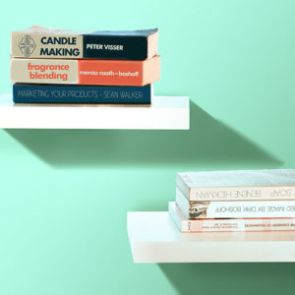Hot Process Recipe – Double Butter Premix
This Double Butter premix of oils is specifically designed to make your life easier.
Our Double Butter premix oils contain a 1000g of oils and butters consisting of the following including 5% superfat:
- Coconut Oil: 35%
- Castor Oil: 5
- Cocoa Butter: 13%
- Olive Oil: 25%
- Shea Butter: 12%
- Palm Oil: 10%
- For this recipe we will use a 33% lye concentration.
Ingredients
- 1x Premix Recipe 2: Double Butter
- 293g Distilled/De-ionised water
- 144g Sodium Hydroxide
- Colorant (optional)
- Fragrance oil or essential oil (optional)
Equipment Needed
You will need the following equipment.
- Slow Cooker/Crock Pot (You could make it on the stove top if you are very careful not to burn the soap. I would recommend you do the double boiler method if you use the stove top instead of a slow cooker)
- Stick Blender
- Spatula
- Spoon
- Separate heat safe container for mixing sodium hydroxide
- Soap mould (this recipe makes roughly 1458.63g of soap and will fit the purple silicone wooden box mould perfectly)
- Infrared thermometer
Method
Preparation
Suit up for safety… Gloves, protective eyewear, mask (when mixing lye), long sleeves, long pants, and close toed shoes.
Prepare your lye solution by measuring 293g of distilled or de-ionised water into a heat safe container.
In a separate container measure out 144g of sodium hydroxide.
Add your sodium hydroxide to your water (NEVER THE OTHER WAY AROUND) and mix thoroughly but gently until your lye is completely dissolved.
Add your premix oils into your Slow Cooker and put it on high until all your oils are completely melted and clear.
Step 1: Melting Once all your oils are melted and warm in the Slow Cooker, you can add your Lye Water Solution. It does not have to cool down before you add it, as the soap will be cooking for at least full hour anyway. Once you add your Lye Water Solution, use your stick blender to blend the soap batter. You can blend to light, medium, or thick trace. This will make no difference in the end bar of soap.
Step 2: Check Different Stages Once your soap has been blended, turn the slow cooker to the low setting and cook for an hour. Keep a close eye on your soap during this process. You may opt to leave your soap and not stir and open it during this time… many Hot Process soap makers do this, and that is fine. I, however, like to keep an eye on it, stir occasionally (every 10 – 15 minutes or so) and check on the different stages the soap goes through during the cooking process.
Champagne Bubbles Stage: This is where the soap starts cooking. You can see small bubbles simmering in some glistening clear liquid. The soap almost looks like its separating. Give it a quick stir, making sure nothing sticks to the side and dries out quicker than the rest of the soap. Cover and leave it again.
Applesauce Stage: The soap becomes a little thicker and almost grainy looking, like applesauce. This stage does not last long and if you miss it, do not worry, your soap will be fine.
Soft Mashed Potato stage: This is the next stage and your soap will look slightly translucent and almost fluffy. This happens after about an hour cooking time. It may take a little longer, even up to 1 and a half hours depending on the amount of heat, different recipes etc. At this stage, your soap is fully cooked.
Step 3: Adding Colourant & Frangrance You can switch off your Slow Cooker (or remove from heat) and add in your colourants and fragrance oil (optional).
*NOTE, Hot Process soap is not like cold process soap, it is thick, and the end bar is often a little rustic looking.
Step 4: Pouring and Moulding You will have to spoon your soap into the mould and tap it down vigorously. You also need to hurry, because as it cools down it will solidify quickly. Focus on getting the majority of the soap in the mould and don’t worry too much about the edges of the pot (the sides usually have some dry pieces and those don’t always want to stick to the rest of the soap) You can get those out later and roll into a little ball and use as a hand soap if you want to.
With gloved hands, smooth out or texture the top of your soap as desired. Remember that the soap will be hot, so be careful. Step 5: Curing As soon as the soap has cooled down, you can unmould and cut your soap into bars.
This soap is fully saponified and technically safe to use immediately, however 4 – 6 weeks cure time is still recommended to form a harder bar of soap that will last longer in the shower/bath.
Prepare your lye solution by measuring 293g of distilled or de-ionised water into a heat safe container.
In a separate container measure out 144g of sodium hydroxide.
Add your sodium hydroxide to your water (NEVER THE OTHER WAY AROUND) and mix thoroughly but gently until your lye is completely dissolved.
Add your premix oils into your Slow Cooker and put it on high until all your oils are completely melted and clear.
Step 1: Melting Once all your oils are melted and warm in the Slow Cooker, you can add your Lye Water Solution. It does not have to cool down before you add it, as the soap will be cooking for at least full hour anyway. Once you add your Lye Water Solution, use your stick blender to blend the soap batter. You can blend to light, medium, or thick trace. This will make no difference in the end bar of soap.
Step 2: Check Different Stages Once your soap has been blended, turn the slow cooker to the low setting and cook for an hour. Keep a close eye on your soap during this process. You may opt to leave your soap and not stir and open it during this time… many Hot Process soap makers do this, and that is fine. I, however, like to keep an eye on it, stir occasionally (every 10 – 15 minutes or so) and check on the different stages the soap goes through during the cooking process.
Champagne Bubbles Stage: This is where the soap starts cooking. You can see small bubbles simmering in some glistening clear liquid. The soap almost looks like its separating. Give it a quick stir, making sure nothing sticks to the side and dries out quicker than the rest of the soap. Cover and leave it again.
Applesauce Stage: The soap becomes a little thicker and almost grainy looking, like applesauce. This stage does not last long and if you miss it, do not worry, your soap will be fine.
Soft Mashed Potato stage: This is the next stage and your soap will look slightly translucent and almost fluffy. This happens after about an hour cooking time. It may take a little longer, even up to 1 and a half hours depending on the amount of heat, different recipes etc. At this stage, your soap is fully cooked.
Step 3: Adding Colourant & Frangrance You can switch off your Slow Cooker (or remove from heat) and add in your colourants and fragrance oil (optional).
*NOTE, Hot Process soap is not like cold process soap, it is thick, and the end bar is often a little rustic looking.
Step 4: Pouring and Moulding You will have to spoon your soap into the mould and tap it down vigorously. You also need to hurry, because as it cools down it will solidify quickly. Focus on getting the majority of the soap in the mould and don’t worry too much about the edges of the pot (the sides usually have some dry pieces and those don’t always want to stick to the rest of the soap) You can get those out later and roll into a little ball and use as a hand soap if you want to.
With gloved hands, smooth out or texture the top of your soap as desired. Remember that the soap will be hot, so be careful. Step 5: Curing As soon as the soap has cooled down, you can unmould and cut your soap into bars.
This soap is fully saponified and technically safe to use immediately, however 4 – 6 weeks cure time is still recommended to form a harder bar of soap that will last longer in the shower/bath.




